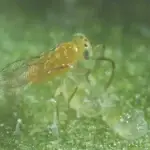Greenhouse Whitefly
Overview
The Greenhouse Whitefly (Trialeurodes vaporariorum) was first observed in tomatoes in America in 1870 and is a major pest in a wide variety of vegetable and ornamental crops around the world.
Greenhouse Whitefly adults are 1.5mm long and have a distinctive white appearance.
The adults tend to lay their eggs onto the soft young plant growth at the top of the plant. Eggs are white and turn black prior to hatching. The whitefly larva is mobile for about a day and then attaches itself to the leaf surface, where it feeds from the plant until it moults into a pupae. During this attached stage, the whitefly is called “scale” because of its scale-like appearance and behaviour. An adult hatches from the pupae and the Greenhouse Whitefly lifecycle repeats.
The two most important factors affecting whitefly population growth are temperatures and the plant host. Greenhouse Whiteflies will continue to breed throughout the year in temperate climates. The whitefly eggs can survive more than 15 days at –3°C and the number of eggs laid by a single female varies greatly depending on the plant species and even varieties of plants within a species.
Greenhouse Whiteflies can be found in conjunction with the Silverleaf Whitefly (Bemisia tabaci).
Why you need to control Greenhouse Whitefly
Greenhouse Whiteflies can be problematic for your crop for several reasons.
At the ‘scale’ stage, Greenhouse Whiteflies secrete honeydew while they feed on the plant cells, which leads to sooty mould growing on the affected leaves and fruit. Not only will this reduce the photosynthetic productivity and general vigour of your plant, but the stained parts of the plant are unsaleable.
Greenhouse Whitefly adults are also vectors of several economically important plant viruses.
It is important to be aware that Greenhouse Whiteflies will quickly develop resistance if you regularly expose them to insecticides. This will compound the risks associated with the effects of whitefly scales (and resultant sooty mould) and the transmission of viruses among your crop.
Beneficial predators to control Greenhouse Whitefly among crops
Biological Services sells a range of products to help you control Greenhouse Whitefiles in your commercial crop and can design a program using different biological controls to manage the pest at different stages of its lifecycle.
This can include the parasitic wasps Encarsia formosa (Encarsia), Eretmocerus warrae (Eretmocerus), the generalist predatory bug Nesidiocoris tenuis (Nesidiocoris) and the predatory mite Typhlodromips montdorensis (Montdorensis).
You can also use yellow sticky traps and rolls to help you monitor and mass-trap Greenhouse Whiteflies.
Get tailored advice for your commercial crop
To speak with one of our qualified consultants about your current commercial crop challenge or to learn about the benefits of the IPM maintenance and monitoring services we provide, contact us.














